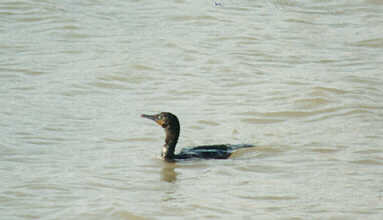The City Naturalist
Double Crested Cormorant
 Article
and Photos by Leslie Day
Article
and Photos by Leslie Day
DOUBLE CRESTED CORMORANT Phalacrocorax auritis (Latin from Greek: phalakros-bald, kora-crow and auritis: Latin-eared or crested)
DESCRIPTION: Some people at the Boat Basin call the cormorant the "Submarine Bird" because it swims so low in the water and then dives and disappears for long periods of time. We never know where it will resurface. Its long neck and pointed head remind us of a periscope, for often, that is all we can see sticking up out of the water.
The coromorant is 29-36 inches long with a wingspread of about 54 inches. It is a large, black bird with a long tail. It has a yellow-orange throat patch. The cormorant's eyes are a brilliant emerald green, with a narrow line around its eyes dotted bright blue. Its double head crest, which appears during its short breeding season, is formed by long, upcurled crown feathers on each side of its head. The cormorant's legs and feet are black. The immature cormorants have lighter, almost white, underparts.
 FEATHERS:
The feathers of the cormorant are not waterproof even though they
possess an oil gland at the base of their tail, as do most birds.
However, their feathers become so saturated with water after they
have been diving, that they must hold their wings open in the sun
and wind in order to dry them. You can often see the cormorants
sitting on top of pilings holding their wings out to dry.
FEATHERS:
The feathers of the cormorant are not waterproof even though they
possess an oil gland at the base of their tail, as do most birds.
However, their feathers become so saturated with water after they
have been diving, that they must hold their wings open in the sun
and wind in order to dry them. You can often see the cormorants
sitting on top of pilings holding their wings out to dry.
FEEDING: The cormorant dives from the surface and swims around looking for prey. It dives to depths of 5 to 25 feet below the surface and stays under from 30 to 70 seconds. Here at the Boat Basin it catches eel and all kinds of fish from large to small: bass, perch, sculpins, herring, etc.. Sometimes you can see it surface with its catch's tail still sticking out of its mouth. It also eats crustaceans such as crabs, shrimp, and crayfish.
 NESTS:
Cormorants nest in colonies. Both the males and females build the
nests which take about 4 days to build. Old nests may be used for
4 years. Nests are built in trees out of sticks and weed stems
and are lined with leafy twigs and grass. Nests built on rocks
are often made of seaweeds and trash gathered at the water's edge
or in diving. Cormorants add objects like feathers and twigs of
evergreen. There is one account of cormorants decorating their
nests with the booty of a sunken trading vessel: pocketknives,
men's pipes, hairpins and ladies' combs.
NESTS:
Cormorants nest in colonies. Both the males and females build the
nests which take about 4 days to build. Old nests may be used for
4 years. Nests are built in trees out of sticks and weed stems
and are lined with leafy twigs and grass. Nests built on rocks
are often made of seaweeds and trash gathered at the water's edge
or in diving. Cormorants add objects like feathers and twigs of
evergreen. There is one account of cormorants decorating their
nests with the booty of a sunken trading vessel: pocketknives,
men's pipes, hairpins and ladies' combs.
EGGS AND NESTLING DEVELOPMENT: Usually 3-4 chalky, pale blue eggs are laid from April through July. They have a single brood but may re-lay if nest or eggs are destroyed. Incubation is 24 days, with both males and females taking turn. Chicks are altricial (naked and helpless at hatching), and their eyes open in 4-5 days. Both parents feed chicks. The first flight of the chicks is usually to water at about 35 days after hatching, but chicks can dive even earlier. They are fully independent at 10 weeks after hatching.
FLIGHT: Cormorants can fly up to 48 m.p.h. They will often fly quite close to the water with their wings flapping quickly, practically touching the river's surface.
RANGE: The cormorant's range is widespread along both coasts of North America and inland along bays, lakes and rivers. The cormorants of the east coast winter from Maryland south to the Gulf Coast.
About Leslie Day | For Further Information
Copyright © 1996-2012 The 79th Street Boat Basin Flora and Fauna Society.
